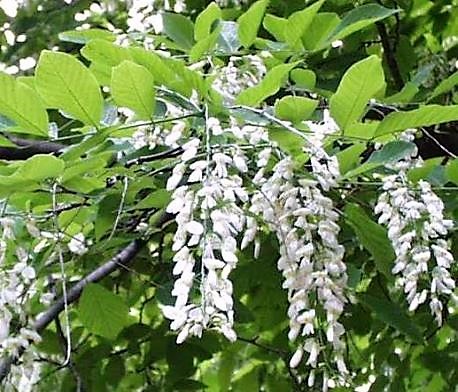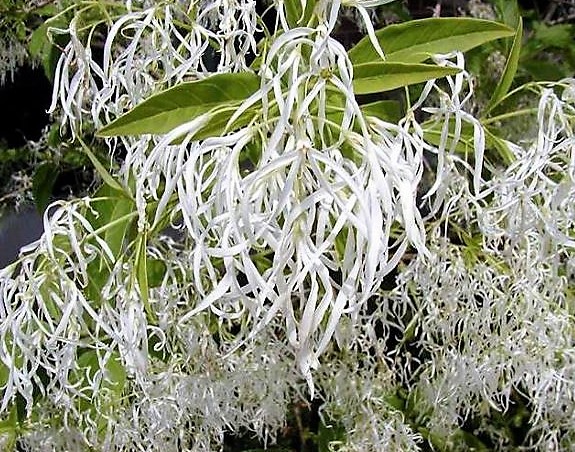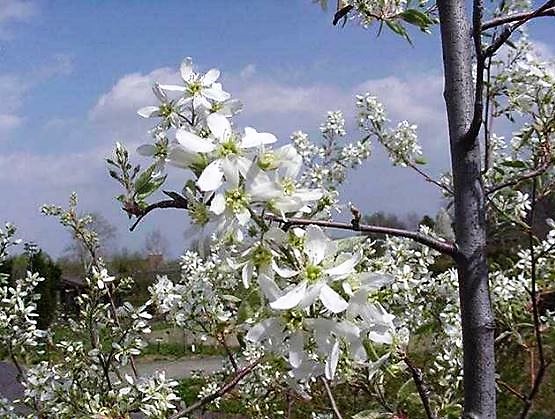Bradford Pear Trees? There Are Better Choices!One Sad Lesson In Invasive Plants - by R. Lieber
Callery Pear (Pyrus calleryana) and Its Surprise Lesson Bradford Pears are just one of several ornamental pear trees, called Callery Pears, that originate from Asia (parts of China, Taiwan and Korea). They were introduced into the US when pressure was on in the horticultural world to find pears resistant to fire blight. Initially, the Bradford Pear - the most promising of several blight resistant varieties - was readily sold here before the earliest specimens had a chance to be observed at maturity. Only then does it display characteristic structural weakness which frequently results with the splitting of large limbs. Bradford Pear is a cold hardy early bloomer, can be planted in a variety of tough conditions, is initially easy to care for, and drops its beautiful leaves later than many other landscape trees. Even Lady Bird Johnson promoted the Bradford Pear by planting one in Washington, D.C.. It has 3 season beauty: spring flowers, summer shape and fall color. It grows fairly quickly and is fairly resistant to many of the problems fruit trees are known for. In the US landscape and horticulture worlds in the late 1960s, many were fascinated with plants, shrubs and trees from exotic, or at least foreign, locations. Arboretums and garden centers extolled alien plants that had new forms, didn't succumb to local pests, or fit new niche garden needs (meditation gardens anyone?). It was a far cry from today's trend to native plants and saving pollinators. When the weak structure of mature Bradford Pears became apparent, there was a great deal of pressure to find a replacement that would be a stronger specimen but have very similar characteristics. Other Callery Pears were bred and began to be sold. One notable variety was marketed as the Cleveland Pear. However, about that time, the surprising new problem arose: although touted as sterile trees, offspring began to appear. It was found that that the sterile tress could in fact cross pollinate with other varieties. These new variety trees were often planted between original pear trees in urban and suburban landscapes, resulting in pollination across very fertile relatives. Dropping fruit generated volunteer sprouts beneath the parent. Far worse, the fruit seeds were carried off by birds and spread far afield. These offspring trees were highly competitive, and soon whole fields and roadside edges were overcome with with them. As a result, America has another invasive species to add to the list; and as these structurally weak trees mature, many of them fail. Replacing Bradfords Wisely Before jumping to the next big thing in landscaping, we hope the lessons learned from the introduction of the Bradford and its cousins, as well as from other invasives such as the Empress Tree and the Mimosa, will stick. Each of these imports has become a problem for local habitats that are fast losing native wildlife. If at all possible look for plants that are native to the East Tennessee area, or are from close neighboring states. A good bet is nativar specimens. The name means native cultivars - natives that have undergone selection and breeding. Sometimes the only difference is a natural mutation someone discovered in a naturally growing specimen and preserved in a garden setting. Recommended alternatives to Callery Pears (includes Bradford Pears) It's hard to find a tree to replace the Bradford that isn't another "import", but various sources have made recommendations for native trees or their nativar offspring. The following varieties includes the most promising choices for right here in Blount County.
Of the non-white flowering alternatives the Eastern Redbud is usually the first to make the list, but there are other natives that can also be quite beautiful.
- Fringe Tree: When in bloom, this tree bears long fringe flowers with dangling petals. In full bloom, it can look like the tree is snow covered. It Is a slow growing tree that may get as tall as 20 feet and often has lovely yellow colored leaves in fall.
- Plum trees (Prunus family of trees): Plum trees will have more of the diseases of fruit trees like blights but are on the list because they are beautiful natives that attract pollinators and make edible fruits as well as pretty fall color. The most recommended are the Chokeberry, Mexican Plum, and Chickasaw Plum.
- Umbrella Magnolia (Magnolia tripetala): This is our final listing. While not really resembling a Bradford Pear, no discussion of native trees with white flowers should omit this choice. All should be aware however that it does share the habit of a bad smelling bloom with Bradfords. |


 In early spring, Blount County erupts in clouds of white puffballs. Driveways and roads are lined with drifts of white blossoms, and many people feel spring is finally here when they see them. In recent years, the more negative aspects of these ubiquitous trees of springtime snow have become obvious. The most obvious is the tendency for the more mature trees in the landscape to split in the ugliest way possible. Another is the special goat-in-a-locker-room smell that comes with the pretty flowers. The surprising new reason to hate a once extremely popular tree is that the offspring of what was supposed to be a sterile tree are popping up everywhere willy-nilly. This picture (when the blooms look their prettiest) shows a whole wooded area being taken over by these new fast growing invaders.
In early spring, Blount County erupts in clouds of white puffballs. Driveways and roads are lined with drifts of white blossoms, and many people feel spring is finally here when they see them. In recent years, the more negative aspects of these ubiquitous trees of springtime snow have become obvious. The most obvious is the tendency for the more mature trees in the landscape to split in the ugliest way possible. Another is the special goat-in-a-locker-room smell that comes with the pretty flowers. The surprising new reason to hate a once extremely popular tree is that the offspring of what was supposed to be a sterile tree are popping up everywhere willy-nilly. This picture (when the blooms look their prettiest) shows a whole wooded area being taken over by these new fast growing invaders.
 - Red Buckeye (Aesculus pavia) is another favorite recommendation. Its a lovely small tree with amazing tubular flowers. To some, the blooms look a little like clusters of small red firecrackers;
- Red Buckeye (Aesculus pavia) is another favorite recommendation. Its a lovely small tree with amazing tubular flowers. To some, the blooms look a little like clusters of small red firecrackers; - Yellowwood (Cladrastis kentukea) has beautiful long trailing bunches of white flowers that appear a little like white Wisteria. The fall leaf color is a pretty yellow. Maps of the trees show Blount County as being one of its natural homes. The only downside that several sources have noted is that young trees can take as much as 12 or more years for it to flower.
- Yellowwood (Cladrastis kentukea) has beautiful long trailing bunches of white flowers that appear a little like white Wisteria. The fall leaf color is a pretty yellow. Maps of the trees show Blount County as being one of its natural homes. The only downside that several sources have noted is that young trees can take as much as 12 or more years for it to flower.
 - Downy Serviceberry (Amelanchie rarborea) or Alleghany Serviceberry (Amelanchie laevis): Another fruit tree which has small berries, similar is appearance to blueberries, that ripen in the summer following delicate white blossoms in spring. Old timers may remember this as Shadblow or Juneberry. Most varieties tend to a red leaf color in the fall. The Tennessee Exotic Pest Plant Council recommends 'Snowcloud' for its upright form.
- Downy Serviceberry (Amelanchie rarborea) or Alleghany Serviceberry (Amelanchie laevis): Another fruit tree which has small berries, similar is appearance to blueberries, that ripen in the summer following delicate white blossoms in spring. Old timers may remember this as Shadblow or Juneberry. Most varieties tend to a red leaf color in the fall. The Tennessee Exotic Pest Plant Council recommends 'Snowcloud' for its upright form.



 - Blackhaw Viburnum (Viburnum prunifolium) and Rusty Blackhaw (Viburnum rufidulum):
- Blackhaw Viburnum (Viburnum prunifolium) and Rusty Blackhaw (Viburnum rufidulum): 
